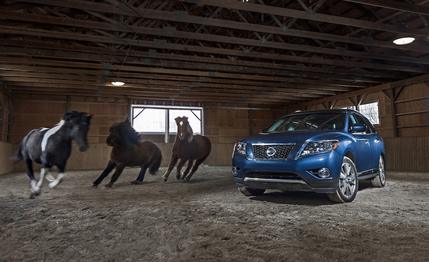 Long-Term Road Test Wrap-Up
Long-Term Road Test Wrap-Up
The SUV is dead. Long live the crossover.
The vehicular mastodons of the 1990s began flirting with extinction as manufacturers and buyers turned to better-behaved family vehicles. These modern, car-based utilities have dumped the off-road hardware, if not always the off-road look, in their attempt to satisfy the considerable “anything but a minivan” crowd.
To that end, Nissan rebuilt its 2013 Pathfinder from the ground up, scrapping its body-on-frame construction, longitudinal powertrain, and available V-8 engine in favor of a unibody design derived from the Altima’s. This brings standard front-wheel drive and a transversely oriented V-6 paired to a continuously variable transmission.
Nissan wasn’t blazing any new trails with this remade Pathfinder, though. It was following the Ford Explorer and GM’s Lambda triplets (Buick Enclave, Chevy Traverse, and GMC Acadia) down the meticulously landscaped, streetlight-lined lanes of suburban America.
As much as the Car and Driver staff fancies V-8–powered coupes and mid-engined roadsters, we have spouses and children and dogs, plus all the physical possessions that come with these fixtures of domesticity. We take vacations and bring these things along. And yes, we occasionally shop at Costco. We signed on for a long-term Nissan Pathfinder because sometimes an enthusiast has no choice but to buy or recommend from a segment with no clear-cut enthusiast option. We were also curious if the changing shape of America’s utility vehicles—lower, lighter, and more efficient—made this Pathfinder crossover any more agreeable than the truck-based Pathfinder it replaced.
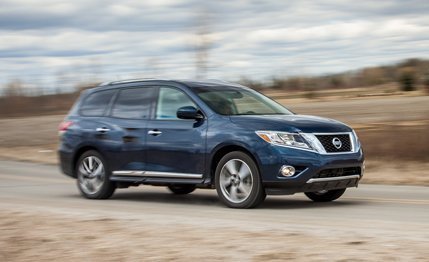 Keep it between the painted lines: The Nissan stumbled in even the mildest of off-road settings, due to its car-based chassis.>Concept Estate.
Keep it between the painted lines: The Nissan stumbled in even the mildest of off-road settings, due to its car-based chassis.>Concept Estate.
Our tester was a four-wheel-drive Platinum model, the highest trim level, which comes with leather, tri-zone climate control, navigation, push-button start, a 13-speaker Bose stereo, and heated and cooled power front seats. Its only options were a set of carpeted floor mats and the Premium package with two DVD monitors in the front headrests and a panoramic sunroof. The window sticker read $44,095, a steep price for family transit, but our staff agreed that the Pathfinder’s level of finish made redundant its mechanical double, the $42,995-to-start Infiniti QX60.
The common core is Nissan’s 3.5-liter VQ V-6, making 260 horsepower and 240 pound-feet of torque and behaving significantly better than we’re used to. Long the industry’s standard-bearer for unpleasant vibrations and unseemly noises, the VQ is now smooth and quiet enough to blend inconspicuously with so many other crossover six-cylinders.
At 4563 pounds, the Pathfinder is relatively light (a four-wheel-drive Ford Explorer weighs 4900 pounds), and it hustles to 60 mph in a respectable 7.2 seconds. In real-world driving, hard acceleration is met with some protest from the CVT. Several drivers complained that the trans hunted for the right ratio in hilly terrain, while others felt it was merely sluggish sliding into a lower ratio. A small contingent of dissenters claimed ambivalence toward the CVT and peppered the logbook with faint praise.
Then the transmission started acting up. One driver said it felt like the engine was lugging in too high a gear, another described it as similar to a misfire, and yet a third characterized it as “rumbles and groans.” We mentioned it at our local Nissan service desk, and the dealer, unable to replicate our experience, dismissed the issue as a normal “fuel-saving measure.”
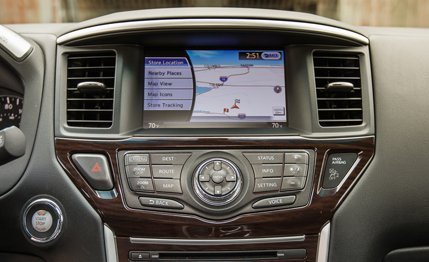 The Pathy's fine infotainment system foiled not even Phillips..
The Pathy's fine infotainment system foiled not even Phillips..
There was nothing normal about what we observed, though. In fact, the internet is rife with stories of Pathfinder owners who experienced more frequent and severe judders. In several cases, Nissan’s fix has been to replace the torque converter, the transmission, or even the whole vehicle. But with trips to California and Montana in the rearview mirror, our Pathfinder passed the final 10,000 miles around the Midwest’s flatlands without any grumblings from the transmission or our drivers.
Though we worried about the health of its CVT, the Pathfinder was otherwise dependable throughout its stay. The few flaws were minor inconveniences. With little more than 5000 miles on the odometer, both daytime running lights burned out and were replaced under warranty. The dealer also reflashed the ECU to revise the transmission programming and updated the ABS controller as part of a recall during separate routine-maintenance visits. Those service stops, which cost about $65 each and happened every 7500 miles, called for oil changes, filter replacements, and tire rotations. Only the 30,000-mile service, which included a brake-fluid flush and battery-terminal cleaning, cost $265.
Our largest out-of-pocket expense came courtesy of another crossover driver. In heavy traffic on Chicago’s Lake Shore Drive, a Chevrolet Traverse rear-ended our Pathfinder, causing $1066 in damage to the Nissan’s rear bumper cover, lower valance, and trailer hitch.
Despite compromised rearward sightlines, we managed to avoid running into anything thanks to the Platinum’s long features list, which includes front and rear parking sensors and Nissan’s brilliant 360-degree, overhead-view camera system. With a clear view of curbs, parking-space markings, and the cars around you, placing the Pathfinder in perpendicular or parallel spots is a breeze. The infotainment system is equally good, combining a touch screen, a control knob, and dedicated climate and audio controls into one of the more user-friendly systems on the market.
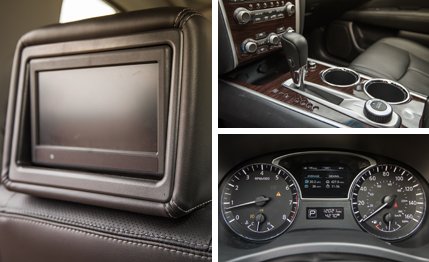
The Pathfinder is utterly minivan-like in its moves. It offers respectable ride quality with nice absorption of big impacts, but the handling behavior is defined by its hefty mass. Nissan’s hydraulically assisted power steering is overboosted and imprecise in every application, and the Pathfinder is no exception. Drivers universally panned our Pathfinder’s inability to track straight on the highway. The large on-center dead spot requires constant sawing at the wheel to keep the crossover on vector. Corners are equally unsatisfying, with minimal change in steering effort through turns.
At the track, the Pathfinder rounded the skidpad at 0.76 g and stopped from 70 mph in 170 feet. That performance puts it right in the thick of the three-row-crossover class, while making it far more tenacious than its predecessor. The last truck-based Pathfinder we tested, a 2010 V-6 model, recorded 0.69 g and 203 feet and needed an extra 0.3 second to hit 60 mph.
We had no illusions about this new Pathfinder’s ruggedness, but we were surprised at just how unhappy it was to leave the pavement. Dispatched to Montana to spend the summer with John Phillips, the Nissan was challenged by craggy dirt roads. “I was shocked at how easily this tall vehicle was getting caught up on rocks and chunks of wood in the road,” Phillips noted. “There’s a suspension piece or a bit of exhaust that hits just about everything.”
The Pathfinder fared far better in snowy, slushy, and icy conditions, helped by a set of Bridgestone Blizzak DM-V1 winter tires. The center console has a large dial to control the four-wheel-drive system, offering two-wheel-drive, auto, and lock settings. But it’s there more for the showroom fiddle factor than for necessity. In any mode, the Pathfinder can act as either a front- or four-wheel-drive vehicle—on demand. The knob doesn’t really serve much purpose.
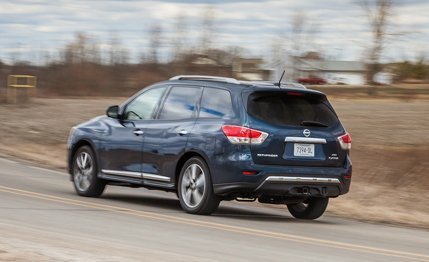
What the Pathfinder does best is cruise for long distances on smooth highways. By SUV standards, the cockpit is quiet, the ride is placid, and eight or nine hours behind the wheel is no big deal. The front seats are plush, and the second row offers generous knee- and legroom, though the low cushion supplies little thigh support for adults. Rear-seat passengers also benefit from good forward visibility and plenty of light from the acreage of glass.
A clever mechanism tips and slides the middle row of seats forward for access to the rear-most chairs. It even works with a child seat installed. The third row is as compromised as in any other vehicle without sliding doors. “Even your kids will soon beg you to buy a minivan,” wrote one driver.
With the rear two rows folded, the Pathfinder makes a practical cargo hauler. We moved a seven-foot-tall bookcase, 500 pounds of driveway sealant, and a 4x8-foot sheet of plywood (cocked at an angle, with the tailgate open) on separate occasions. The Pathfinder’s 5000-pound towing capacity was put to the test only a handful of times because our long-term Mercedes-Benz GL450 and Ram 1500 were better suited to the task. During a cross-country run with a U-Haul trailer in tow, executive editor Aaron Robinson came away underwhelmed by the Pathfinder. “The engine has no power and a terrible thirst,” he wrote. Our fuel economy over 40,000 miles averaged 20 miles per gallon, 1 mpg less than the EPA’s estimated combined city/highway rating. If there’s a fuel-economy benefit to the CVT, we managed to circumvent it.
Still, there’s no question that the reformatted Pathfinder qualifies as progress for everyone except off-roading enthusiasts. The unibody family hauler is quicker, more agile, and more efficient than the body-on-frame utility it replaced. Yet the new Pathfinder offers a similar experience to the old: a cavernous interior tempered by mediocre driving dynamics. Senior online editor Ron Sessions summed it up after a holiday trip to Pennsylvania with passengers, presents, and a dog. “Driven like a minivan, it doesn’t disappoint,” he said. Well, at least it doesn’t look like a minivan.
Rants and Raves Mike Sutton: This thing really feels like a high-riding minivan. The cab forwardness, light steering, and dash layout of this redesigned Pathfinder all say "school bus." John Phillips: Every move is an exercise in initial lethargyslow step-off, all primary inputs as thick as molasses. Ron Sessions: The steering continues to be an enigma. On a dead-straight section of interstate, I'm waddling back and forth in my lane like a penguin. Erik Johnson: The Pathfinder's comfort and the amenities of the Platinum trim have me wondering why anyone would spend the extra money for an Infiniti QX60. Dave Ferguson: Over several snowy 10,000- and 12,000-foot passes, the Pathfinder delivered good power, traction, and braking at all times. Aaron Robinson: Apparently the delightful Juke was a dead end, because none of that car's spirit is present in this slug. Jeff Sabatini: The steering has a weird way of lightening up as you dial in the effort. Austin Lindberg: Around town in icy conditions, it handled everything admirably. Eddie Alterman: The second-row seats' folding-and-sliding function is a paragon. David Beard: The steering requires a decent amount of driver input to keep the Pathfinder in line, but after a few hundred miles, I no longer noticed it.